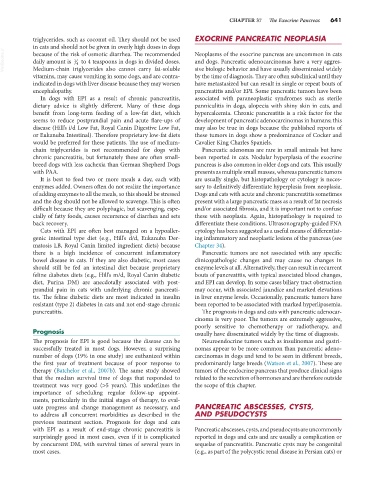Page 669 - Small Animal Internal Medicine, 6th Edition
P. 669
CHAPTER 37 The Exocrine Pancreas 641
triglycerides, such as coconut oil. They should not be used EXOCRINE PANCREATIC NEOPLASIA
in cats and should not be given in overly high doses in dogs
VetBooks.ir because of the risk of osmotic diarrhea. The recommended Neoplasms of the exocrine pancreas are uncommon in cats
4 to 4 teaspoons in dogs in divided doses.
and dogs. Pancreatic adenocarcinomas have a very aggres-
daily amount is
1
Medium-chain triglycerides also cannot carry fat-soluble
by the time of diagnosis. They are often subclinical until they
vitamins, may cause vomiting in some dogs, and are contra- sive biologic behavior and have usually disseminated widely
indicated in dogs with liver disease because they may worsen have metastasized but can result in single or repeat bouts of
encephalopathy. pancreatitis and/or EPI. Some pancreatic tumors have been
In dogs with EPI as a result of chronic pancreatitis, associated with paraneoplastic syndromes such as sterile
dietary advice is slightly different. Many of these dogs panniculitis in dogs, alopecia with shiny skin in cats, and
benefit from long-term feeding of a low-fat diet, which hypercalcemia. Chronic pancreatitis is a risk factor for the
seems to reduce postprandial pain and acute flare-ups of development of pancreatic adenocarcinomas in humans; this
disease (Hill’s i/d Low Fat, Royal Canin Digestive Low Fat, may also be true in dogs because the published reports of
or Eukanuba Intestinal). Therefore proprietary low-fat diets these tumors in dogs show a predominance of Cocker and
would be preferred for these patients. The use of medium- Cavalier King Charles Spaniels.
chain triglycerides is not recommended for dogs with Pancreatic adenomas are rare in small animals but have
chronic pancreatitis, but fortunately these are often small- been reported in cats. Nodular hyperplasia of the exocrine
breed dogs with less cachexia than German Shepherd Dogs pancreas is also common in older dogs and cats. This usually
with PAA. presents as multiple small masses, whereas pancreatic tumors
It is best to feed two or more meals a day, each with are usually single, but histopathology or cytology is neces-
enzymes added. Owners often do not realize the importance sary to definitively differentiate hyperplasia from neoplasia.
of adding enzymes to all the meals, so this should be stressed Dogs and cats with acute and chronic pancreatitis sometimes
and the dog should not be allowed to scavenge. This is often present with a large pancreatic mass as a result of fat necrosis
difficult because they are polyphagic, but scavenging, espe- and/or associated fibrosis, and it is important not to confuse
cially of fatty foods, causes recurrence of diarrhea and sets these with neoplasia. Again, histopathology is required to
back recovery. differentiate these conditions. Ultrasonography-guided FNA
Cats with EPI are often best managed on a hypoaller- cytology has been suggested as a useful means of differentiat-
genic intestinal type diet (e.g., Hill’s d/d, Eukanuba Der- ing inflammatory and neoplastic lesions of the pancreas (see
matosis LB, Royal Canin limited ingredient diets) because Chapter 34).
there is a high incidence of concurrent inflammatory Pancreatic tumors are not associated with any specific
bowel disease in cats. If they are also diabetic, most cases clinicopathologic changes and may cause no changes in
should still be fed an intestinal diet because proprietary enzyme levels at all. Alternatively, they can result in recurrent
feline diabetes diets (e.g., Hill’s m/d, Royal Canin diabetic bouts of pancreatitis, with typical associated blood changes,
diet, Purina DM) are anecdotally associated with post- and EPI can develop. In some cases biliary tract obstruction
prandial pain in cats with underlying chronic pancreati- may occur, with associated jaundice and marked elevations
tis. The feline diabetic diets are most indicated in insulin in liver enzyme levels. Occasionally, pancreatic tumors have
resistant (type 2) diabetes in cats and not end-stage chronic been reported to be associated with marked hyperlipasemia.
pancreatitis. The prognosis in dogs and cats with pancreatic adenocar-
cinoma is very poor. The tumors are extremely aggressive,
poorly sensitive to chemotherapy or radiotherapy, and
Prognosis usually have disseminated widely by the time of diagnosis.
The prognosis for EPI is good because the disease can be Neuroendocrine tumors such as insulinomas and gastri-
successfully treated in most dogs. However, a surprising nomas appear to be more common than pancreatic adeno-
number of dogs (19% in one study) are euthanized within carcinomas in dogs and tend to be seen in different breeds,
the first year of treatment because of poor response to predominantly large breeds (Watson et al., 2007). These are
therapy (Batchelor et al., 2007b). The same study showed tumors of the endocrine pancreas that produce clinical signs
that the median survival time of dogs that responded to related to the secretion of hormones and are therefore outside
treatment was very good (>5 years). This underlines the the scope of this chapter.
importance of scheduling regular follow-up appoint-
ments, particularly in the initial stages of therapy, to eval-
uate progress and change management as necessary, and PANCREATIC ABSCESSES, CYSTS,
to address all concurrent morbidities as described in the AND PSEUDOCYSTS
previous treatment section. Prognosis for dogs and cats
with EPI as a result of end-stage chronic pancreatitis is Pancreatic abscesses, cysts, and pseudocysts are uncommonly
surprisingly good in most cases, even if it is complicated reported in dogs and cats and are usually a complication or
by concurrent DM, with survival times of several years in sequelae of pancreatitis. Pancreatic cysts may be congenital
most cases. (e.g., as part of the polycystic renal disease in Persian cats) or

